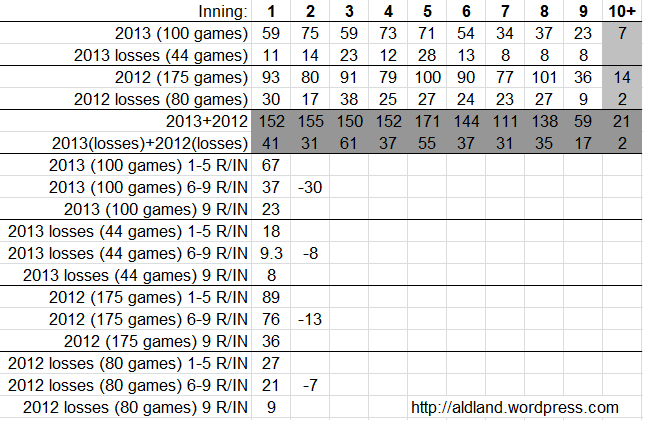Bay of Cigs: 100 Days of Summer Run Distribution
 I celebrated tax day this year by taking a dive into the numbers behind the Detroit Tigers’ offensive production. Since last season, I had developed the feeling that this should-be offensive power was having trouble scoring late in games, hamstringing their ability to mount comebacks and generally secure a win in the later innings, and I wanted to investigate to see whether that really was the case.
I celebrated tax day this year by taking a dive into the numbers behind the Detroit Tigers’ offensive production. Since last season, I had developed the feeling that this should-be offensive power was having trouble scoring late in games, hamstringing their ability to mount comebacks and generally secure a win in the later innings, and I wanted to investigate to see whether that really was the case.
The evidence I gathered in April appeared to support my hypothesis. The 2013 season was just twelve games old, though, and it was difficult to ascribe too much meaning to data gathered from such a small sample set. As of today, however, Detroit has played one hundred games in the 2013 campaign, so I decided to update the numbers:
 (Hover over image for detailed description. Click to expand.)
(Hover over image for detailed description. Click to expand.)
If anything, the effect has become more pronounced. Focus on the differential in R/IN (runs per inning totals to this point). Right now, the Tigers have scored thirty more runs in the first five innings of games than they have in the last four, or about a forty-five percent reduction. It’s an eight run difference when looking only at losses, but the ratio, forty-eight percent, is similar. Yes, this compares five innings of data to four, and sometimes the ninth inning isn’t played, but those caveats apply to both the early season data and last season’s, where the late-game falloff (-13/15% and -7/22%) was far less significant.
Acknowledging some constructive criticism I received the last time I presented this data, I agree that merely breaking out losses may not precisely indicate that the Tigers were unable to mount a comeback, since they obviously weren’t able to in those games, but I do think that highlighting losses was a valid pre-collection decision, because doing so might have shown that a dearth of late-inning scoring was a particular problem that contributed to the team losing. Without deeper analysis, I do not think the above numbers, as currently presented, support that notion, however. The dropoff appears to be similar across all games.
A secondary observation from this data is that the Tigers are on pace to score many more runs overall this year than they did last year. Through one hundred games, they’ve scored 505 runs, good enough for second in the AL. They scored 726 runs in the 2012 regular season, making them just the first team above the AL average. They’re on pace to finish with 818 runs this year, nearly one hundred more than last year.
While the above data confirms my feeling that the Tigers were having trouble scoring late in games– they didn’t score their first ninth-inning run until April 19— and therefore mounting comebacks, it also supports my derivative assertion, which is that Detroit’s problem is not just its bullpen, but the combination of a group of relief pitchers who can’t hold leads and a group of batters who can’t retake lost leads (or add insurance runs to help preserve leads). The bullpen likely will be the easiest to fix with a personnel move late this summer, but general manager Dave Dombrowski and company need to remember that this team’s main problem has multiple components.
Alec is a founding contributor at ALDLAND and a writer at Banished to the Pen and TechGraphs. He interfaces with sports twitter @ALDLANDia.
`
Ever thought of a rate stat? I would guess it is fairly normal for EVERY team to score less in later innings because opposing managers are throwing high leverage flame throwerts, specialists and stuff at them.
Would be nice if you checked that.
Thanks for the comment, AC. There undoubtedly are reasons why every team might score less in later innings. I think the data I presented above at least indicates that the 2013 Tigers are scoring less late than they did in 2012, even with a significant increase in total runs scored.
Tracking all other teams this season surely would provide additional, helpful context. It seems like gathering the data to provide that additional context could be pretty tedious, though. Do you have any specific suggestions for me in that regard?
Finally updated this with the full 2013 season information and some team-to-team comparisons: https://aldland.wordpress.com/2014/06/02/flying-tigers-closing-the-book-on-2013/.
Updated the information in the above post, available here: https://aldland.wordpress.com/2014/06/02/flying-tigers-closing-the-book-on-2013/.